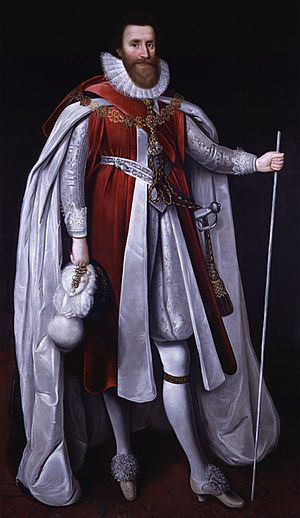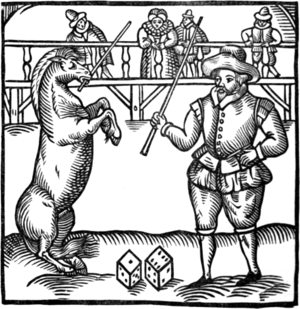The Masque of Indian and China Knights facts for kids
The Masque of Indian and China Knights was a special show performed at Hampton Court in Richmond, England. It happened on January 1, 1604. A masque was a type of play or performance popular in those days. It included music, dancing, fancy costumes, and often a story. This particular masque was never printed, so we only know about it from a letter written by a man named Dudley Carleton. Some historians also call it the Masque of the Orient Knights.



Contents
Why This Masque Was Special
This masque was performed when the royal family returned to London. They had left because of a serious illness called the plague. The households of Anne of Denmark, the Queen, and Prince Henry, her son, had been staying in Winchester. They had enjoyed another masque there in October. The French ambassador, Christophe de Harlay, Count of Beaumont, heard that Queen Anne was planning even bigger and more expensive shows for Christmas. This masque and another one called The Vision of the Twelve Goddesses were those shows.
Who Organized the Masque?
Arbella Stuart, a noblewoman, wrote that this Masque of Knights was planned by a group of male courtiers, not by the Queen herself. She wrote in December 1603 that she was part of their secret plans. She said, "Certain noblemen... intend another." On December 21, Dudley Carleton wrote that the Duke of Lennox was the main organizer for the masques performed by men. He said, "We shall have a merry Christmas at Hampton Court, for both male and female masques are all ready bespoken."
Knights from Faraway Lands
The main idea of the masque was about knights visiting England from distant countries. These knights came to the court of the new King, James I. Their "foreign" look might have helped people think about the differences between Scottish and English courtiers. The show even had a Chinese magician. He described his imagined country as a kind of perfect place.
Performances like this were not new in England. In 1512, twelve performers dressed "after the manner of Italy" arrived in a masque. In 1527, Henry VIII and his courtier shepherds came to Hampton Court in a show. Similar shows also happened in Scotland. In 1563, shepherds arrived at Castle Campbell for a wedding masque. In 1579, a masque called Navigatioun was performed. It featured a narrator and his friends, a "Turk, the More, and the Egyptien," entering with torches.
At the party for King James's baptism in 1566, Indian water spirits (nereids) were shown using compasses to find their way to Stirling Castle. The Indian knights at Hampton Court might have represented people from the Americas.
The Duke of Lennox's Role
The show at Hampton Court might have been influenced by French performances. The French ambassador said the Duke of Lennox's show was organized "à la Française" (in the French style). The Earl of Worcester also called another show a "ballet" instead of a masque. There were some similarities between the Masque of Knights and a French show called Ballet des Princes de la Chine from 1601. One of the performers in the 1604 masque, Lord Aubigny, who was the Duke of Lennox's younger brother, might have seen this French ballet.
Historian David Bergeron points out that the Duke of Lennox had helped plan other royal events before. These included the welcome for Queen Anne in 1590 and a masque for Prince Henry's baptism in 1594.
The Masque Performance
According to Dudley Carleton's report, the masque happened at night. It followed a play about Robin Goodfellow, which was probably A Midsummer Night's Dream.
The show began with a scene of Heaven built in the hall. From there, a Chinese magician gave a long speech. He described his country, saying it was strong and rich, like England. He then announced that "certain Indian and China knights" were arriving. He said he had magically brought them to Hampton Court on clouds. A curtain was then pulled back to show the performers, who were playing the knights. They carried torches and lanterns. After some songs, the knights went up to the King, one by one.
William Herbert, the Earl of Pembroke, gave King James a shield with a special poem on it and explained it. He also gave the King a very expensive jewel. Dudley Carleton wrote that King James was planning to buy this jewel. The jewel was likely a diamond with a pearl and a ruby ring, which cost £760.
The other knights also presented shields with their own symbols. Philip Herbert's shield showed a horse in a green field. He said it was a descendant of Alexander the Great's famous horse, Bucephalus. The King then made a joke about a showman named Bankes who had a dancing and calculating horse. After this, the formal dance of the masque began.
Next, Queen Anne of Denmark and her ladies joined the dancing. The knights "took them out" from the audience to dance. Some of the ladies included the Countess of Bedford, the Countess of Hertford, Susan Vere, Penelope Rich, and Lady Southwell. The show ended when the magician returned and revealed who the eight masked English and Scottish courtiers really were.
Some of the music from the January 1604 masques at Hampton Court was copied down by Nicholas Le Strange.
A courtier named Roger Wilbraham wrote down his thoughts on the shows and their costs in January 1604. He said that King James hosted ambassadors from France, Spain, and Poland. There were many plays and dances, including one masque by English and Scottish lords. Another masque was by the Queen and eleven ladies, who gave gifts as goddesses. He thought these shows, especially the last one, cost a lot of money for costumes, music, songs, and jewels.
The Masque Performers
The eight courtiers who performed wore special costumes. They had robes of crimson (dark red) satin embroidered with gold. They also had silver lace over silver doublets (jackets), with swords and hats that had an Indian bird feather. Dudley Carleton said these costumes were too heavy for dancing.
The performers were:
- Thomas Somerset, who was in charge of Queen Anne's horses.
- Henry Goodere, a friend of the famous poet John Donne.
- William Herbert.
- Philip Herbert.
- Ludovic Stewart, 2nd Duke of Lennox.
- Esmé Stewart, Lord Aubigny, who was the Duke of Lennox's younger brother.
- James Hay.
- Richard Preston.

